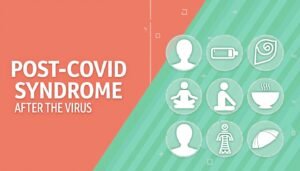Introduction
The COVID-19 pandemic has left an indelible mark on global health, with millions of people recovering from the acute phase of the virus. However, for a significant number of individuals, the journey doesn’t end with a negative test. Many continue to experience lingering symptoms long after the initial infection has passed, a condition now widely recognized as Long COVID.
Long COVID, also referred to as Post-COVID Syndrome or Post-Acute Sequelae of SARS-CoV-2 Infection (PASC), encompasses a wide range of physical, neurological, and mental health symptoms that persist for weeks, months, or even years. These symptoms can severely impact daily life, making recovery a challenging and often frustrating process.
Understanding Long COVID is more critical than ever as researchers work to uncover its causes, identify effective treatments, and improve diagnostic tools. Early recognition and proactive management can significantly enhance long-term outcomes, helping individuals regain their quality of life.
This article aims to provide a comprehensive guide to Long COVID, covering its symptoms, diagnosis, recovery strategies, and the latest research. Whether you’re experiencing persistent symptoms, supporting a loved one, or simply seeking to stay informed, this guide will equip you with the knowledge to navigate this complex condition.
1. What is Long COVID?
Definition and Terminology
Long COVID refers to a collection of symptoms that persist or emerge after the acute phase of a COVID-19 infection. It is also known by other terms, such as Post-COVID Syndrome or Post-Acute Sequelae of SARS-CoV-2 Infection (PASC). Unlike the acute phase, which typically resolves within a few weeks, Long COVID can last for months or even years, affecting multiple organ systems.
How Long COVID Differs from Acute COVID-19
While acute COVID-19 is characterized by symptoms like fever, cough, and shortness of breath during the active infection, Long COVID involves a broader and more persistent set of symptoms. These can range from fatigue and brain fog to cardiovascular and gastrointestinal issues, often fluctuating in intensity.
Prevalence and Affected Populations
Studies suggest that 10-30% of COVID-19 survivors experience Long COVID symptoms, regardless of the severity of their initial infection. Even individuals with mild or asymptomatic cases can develop Long COVID, though it is more common in those who had severe illness.
Risk Factors
Certain factors increase the likelihood of developing Long COVID:
- Age: Older adults are more susceptible, though younger individuals are not immune.
- Gender: Women appear to be at higher risk than men.
- Severity of Initial Infection: Severe COVID-19 cases are more likely to lead to Long COVID.
- Preexisting Conditions: Chronic illnesses like diabetes, hypertension, or autoimmune disorders can increase vulnerability.
- Vaccination Status: Unvaccinated individuals are at higher risk compared to those who are vaccinated.
2. Symptoms of Long COVID
Long COVID symptoms are diverse and can affect nearly every system in the body. It presents a wide range of symptoms, varying in severity. Some of the most common include:
They are often categorized into the following areas:
Respiratory Symptoms
- Shortness of breath: Difficulty breathing, even during light activities.
- Chronic cough: A persistent cough that lingers for weeks or months.
- Chest tightness: A feeling of pressure or discomfort in the chest.
Neurological Symptoms
- Brain fog: Difficulty concentrating, memory issues, and mental fatigue.
- Headaches and dizziness: Frequent or severe headaches and feelings of lightheadedness.
- Sleep disturbances: Insomnia or disrupted sleep patterns.
Cardiovascular Symptoms
- Heart palpitations: Irregular or rapid heartbeats.
- Chest pain: Discomfort or pain in the chest area.
- Postural Orthostatic Tachycardia Syndrome (POTS): A condition causing dizziness and rapid heart rate upon standing.
Fatigue and Energy Levels
- Persistent exhaustion: Overwhelming fatigue that doesn’t improve with rest.
- Post-exertional malaise (PEM): Worsening of symptoms after physical or mental exertion.
Gastrointestinal Symptoms
- Nausea and diarrhea: Digestive issues that persist long after the acute infection.
- Loss of appetite: Reduced desire to eat, leading to weight loss or malnutrition.
Mental Health Impacts
- Anxiety and depression: Persistent feelings of worry, sadness, or hopelessness.
- PTSD-like symptoms: Flashbacks or heightened stress related to the COVID-19 experience.
Other Symptoms
- Joint and muscle pain: Persistent aches and stiffness.
- Loss of taste or smell: A lingering or altered sense of taste and smell.
- Skin rashes: Unexplained rashes or skin irritations.
The variability and unpredictability of these symptoms make Long COVID particularly challenging to manage.
3. Diagnosing Long COVID
Challenges in Diagnosis
There is no single test for Long COVID, making diagnosis complex. Symptoms often overlap with other conditions, requiring a thorough evaluation to rule out alternative causes..
Diagnostic Approaches
Physicians rely on a combination of symptom assessment, medical history, and ruling out other conditions:
- Patient-reported experiences: Detailed accounts of symptoms and their progression.
- Medical history: Review of the patient’s COVID-19 infection and preexisting conditions.
- Blood tests: To check for inflammation, clotting issues, or vitamin deficiencies.
- Imaging: Chest X-rays or CT scans to assess lung damage.
- Pulmonary function tests: To evaluate respiratory health.
- Cognitive assessments: To identify brain fog or memory issues.
- Brain scans or neurological exams for cognitive symptoms.
- Echocardiograms or heart monitoring for cardiovascular issues.
Multidisciplinary Approach
Diagnosing Long COVID often requires multidisciplinary approach, collaboration among specialists, including pulmonologists, cardiologists, neurologists, and mental health professionals.
4. Recovery and Management Strategies
Recovery from Long COVID varies greatly from person to person. Some individuals recover within a few months, while others experience symptoms for years. While there is no universal cure, several strategies can help manage symptoms and improve quality of life.
Lifestyle Adjustments:
- Rest and Pacing: Avoid overexertion to prevent worsening symptoms.
- Balanced Nutrition: Eating anti-inflammatory foods, staying hydrated, and avoiding processed foods can support recovery.
- Gentle Exercise: Light movement like yoga or walking, while avoiding overexertion, can help maintain strength.
Medical Interventions
- Symptom-specific treatments: Inhalers for respiratory issues, cognitive therapy for brain fog, and physical therapy for joint pain.
- Medications: Under medical supervision, certain drugs may help manage symptoms.
- Physical therapy for mobility and joint pain.
Mental Health and Emotional Support
- Therapy and mindfulness: Cognitive-behavioral therapy (CBT) and meditation can reduce anxiety and depression.
- Support groups: Connecting with others experiencing Long COVID can provide emotional relief.
Alternative and Holistic Approaches
- Acupuncture: May help alleviate pain and improve energy levels.
- Breathing exercises: Techniques like diaphragmatic breathing can enhance lung function.
- Dietary supplements: Consult a healthcare provider before trying supplements like vitamin D or omega-3s.
5. Current Research and Emerging Treatments
Understanding and managing Long COVID is a challenge, but ongoing research is shedding light on its underlying mechanisms and potential treatments. As scientists and healthcare professionals work to develop effective solutions, recent findings offer hope for better care and recovery options. Scientists and healthcare professionals are working tirelessly to understand Long COVID and develop effective treatments. Recent studies, such as exploring the use of antiviral drugs like Paxlovid in reducing persistent symptoms, offer promising insights into potential treatment pathways.
Key Research Findings:
- Long COVID may result from an overactive immune response, chronic inflammation, or lingering viral fragments.
- Studies suggest a connection between Long COVID and mitochondrial dysfunction, which affects energy production in cells.
- Researchers are investigating the role of gut microbiota in symptom persistence.
Potential Treatments in Clinical Trials:
- Antiviral drugs targeting persistent viral particles.
- Immune-modulating therapies: Reducing overactive immune responses.
- Anti-inflammatory medications to reduce immune system overreaction.
- Monoclonal antibodies to help modulate immune response.
Global Research Efforts:
- The World Health Organization (WHO) and National Institutes of Health (NIH) have dedicated resources to studying Long COVID.
- Governments worldwide are funding initiatives to track long-term COVID effects and improve patient care.
6. Future Outlook and the Road Ahead
The future of Long COVID research and treatment looks promising, with ongoing studies exploring targeted antiviral therapies, immune-modulating treatments, and potential biomarkers. Scientists continue to uncover new insights, which could lead to better diagnostic tools and targeted treatments. Advocacy efforts are also pushing for Long COVID to be recognized as a disability, ensuring workplace accommodations and financial support for those affected.
As awareness grows, more individuals will receive the care and resources needed to navigate their recovery journey.
Conclusion
Long COVID is a complex and evolving condition that affects millions globally. While recovery can be challenging, ongoing research and medical advancements provide hope. If you or someone you know is experiencing Long COVID, seeking medical support, implementing lifestyle changes, and staying informed can make a significant difference.
If you found this article helpful, share it with others to spread awareness. If you suspect you have Long COVID, consult a healthcare professional for proper evaluation and management. Subscribe to our newsletter for the latest updates on Long COVID and other health topics.
Call to Action:
Share this article to raise awareness about Long COVID. If you suspect you have Long COVID, consult a healthcare professional for proper evaluation and management. Subscribe to our newsletter for updates on Long COVID and other health topics.




